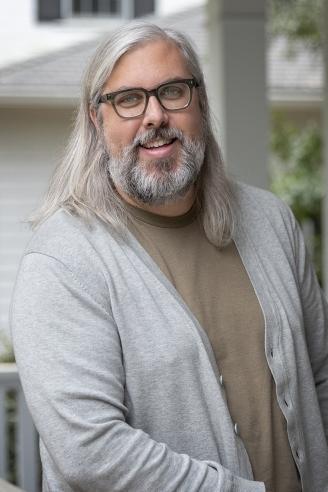Dear reader, I have a slight confession to make. Less of confession perhaps, and more of a framework for the space that I would like to invite you into over the next few minutes.
I love horror stories. Films, books, video games… give me a good scare, a shiver down my spine, an unnerving experience that lingers in my brain and under my skin for a few days and, paradoxically perhaps, I am a happy man. I know I’m not alone in this, as horror movies continue to be successful at the box office and scary stories fill our streaming platforms. But I also know that there are plenty of folks who find the notion, especially from a theological standpoint, to be almost abhorrent. Why tarry in the presence of evil, even if imagined?
Rather than attempt to give a spiritual defense of the entire genre (that would take a lot more time and space), I’d like to zero in on one particular film, and even more specifically, one particular element of the film and use it as a key example of one of the vital lessons we can glean from horror in the process.
The film? The Texas Chain Saw Massacre (hereafter referred to as TCM).
The element? The score.
Briefly for the uninitiated, TCM is regarded as one of the greatest horror films ever made. A group of eight critics compiled a list of the top 100 horror movies of all time last year for Variety and at the top of that list? TCM. 1 Esquire included it in an unranked list last year as well, compiling their “100 Scariest Movies of All Time.” 2 Going back a few years, Total Film also ranked it No. 1 in 2005 for their list of the top 50 horror movies of all time, 3 while TIME placed it 11th on their top 25 horror film list of 2007. 4
The score of The Texas Chain Saw Massacre invites us into a space of formation to learn how to be better listeners. … [It helps us] pay better attention to small details, to nuances that might otherwise go overlooked.Released in 1974, it tells the tale of a group of friends driving through Texas and chronicles their demise at the hands of the Sawyers, a family of cannibals. Directed by horror master Tobe Hooper, it tuned into a variety of American cultural wavelengths, including then-current fears of serial killers, the unrest of the mid-70s due to the Vietnam war, social upheaval, and a growing distrust of the government and Nixon’s administration. 5 It also gave the horror genre one of its most enduring icons, Leatherface, the character who wears the faces of his victims and wields butchering tools and the titular chainsaw in the killing of the teenagers who have the misfortune to cross his family’s path.
Now, if you’ve never seen the film, you might be surprised to learn that, at least by more modern standards of horror, TCM is not particularly bloody or gory. It’s punctuated by moments of stark violence, but much of the shock is communicated by way of the editing and the atmosphere in the movie. As someone who grew up in the American South, TCM manages to convey a sense of the oppressive heat in this region in such a tangible way, you can practically feel the sunbaked fever dream emanating from the screen. Along with the actual characters in the story, the sense of heat is practically its own, making it feel more alive. The other ‘bonus’ character, completely unseen but heard and felt, perhaps even subconsciously, is the score.
Given TCM’s accolades, one would assume that its soundtrack has also been collected and appreciated for decades. The film itself has been reissued multiple times over the 51 years since its release, in various video formats and box sets. Ironically, while score has been sought out for a long time, 2024 marked the first time that it has ever been available in an official capacity. Waxwork Records worked alongside co-composer Wayne Bell (director and co-composer Tobe Hooper passed away in 2017) to track down the original master tapes in 2023 and a formal release finally occurred last year. 6 What made the score so difficult to locate and why is it so effective within the movie itself?
I believe that the answer to both questions is due to the experimental nature of the soundtrack and its creation. In the liner notes of the score, Bell recounts how the process of creation worked for TCM:
We recorded way more music than we needed. Hours and hours of sound, some of it remarkable, some of it laughable. And we laughed a lot. Tobe and I were both confident music editors, he from cutting all his own films, and I from my work in network radio production. So we knew that we would compose partly by editing. And as always happens in editing, some good pieces end up on the cutting room floor. 7
The experimentation that Bell is recalling is fantastic for the process of creation, especially for a film like TCM, but it’s not conducive to long-term documentation and archiving. A portion of the rundown of the instruments and implements used by Bell and Hooper reads like a list of items you’d find at a yard sale: an 11-inch solid aluminum saucepan, a children’s toy percussion set, and various wildlife calls, whistles, and shakers. 8 Along with the more traditional instruments (cymbals, an upright bass, a lap steel guitar), the sounds of what they created in the early 70s are not that of a traditional orchestral soundtrack, with each section’s music mapped out via notation on sheet music. This isn’t a John Williams score in the style of classical, leitmotif composition. Given the amount of audio that Bell says that they recorded, I suspect that he and Hooper were recording in an unstructured manner, improvising and testing out what they captured and then trimmed it down to fit the visuals. This process doesn’t necessarily lend itself to preserving what they were making as they went along or what they exercised in the process of editing.
By not shying away from the ugly, abrasive sounds, we open up our ears to new wavelengths, developing an appreciation for the unknown and the off-putting—and in the process, … we can become more caring, empathetic people.And yet, the instinctual nature of the sounds created are absolutely perfect for TCM. The visceral experience of the film itself is matched by the sounds of the score. It’s metal scraping metal, rattles that sound like they’re coming from a snake or clicking beetles, the whine of the physical tension of the implements, the layering of whistles and snapping sounds, the slow ringing of cymbals in the distance, strange echoes and delays, the sonic ratcheting up of emotion. The cumulative effect is an uneasy auditory journey, from start to finish. Even if the visuals themselves aren’t always dowsed in gallons of viscera and blood, the industrial/noise nature of the score is fundamental in conveying the dread and terror of what’s happening to the roadtripping victims of the Sawyer family.
So what are we to make of this theologically? What opportunities are presented to us by way of this soundtrack?
I believe that this score invites us into a space of formation to learn how to be better listeners. Depending on how plugged in you are with various sources of media (news outlets, streaming platforms, Reddit feeds, social media, and so on), you might be inundated constantly with items hellbent on capturing your attention. At the very least, that’s certainly the case for my life and for many of my friends and colleagues. One of the possible implications of that constant input is the eroding of our ability to zero in and actually listen to one thing at a time. To turn off the impulse or need to multi-task and actually be present, either with one singular source of information or even more crucially, with an individual in your life. In Scripture, there are various passages where noise is documented preceding silence, being used as a sort of clearing ground for the presence of God.
While I’m not suggesting that listening to the score of TCM will necessarily usher in a divine encounter for your life, I do think that developing a habit of close listening to sound/noise collages helps discipline your ears and brain to pay better attention to small details, to nuances that might otherwise go overlooked. What if sharpening those skills could also help make us better friends and community members? More loving companions to those we encounter in life who desperately need a kind heart and a listening ear?
I’m fortunate to be a part of various creative circles that include musicians and projects focused on noise and sound textures. Alongside the innovations found in TCM’s score, groups like HEP LAD and artists like Open Casket Soundsystem, hell on hearth, Touching Grass, and Ministry of Apathy build their albums by paying close attention and documenting the sounds that they encounter in their daily lives, while also using sound-making gear in creative and improvisatory ways, perhaps not too dissimilar to Bell and Hooper. As contradictory as it might sound, given how initially off-putting noise albums can be, the starting points of folks like these are anchored in exploration, curiosity, and an openness to hear what others are saying.
It’s that posture of openness that I believe is nurtured by a sonic experience like the TCM score. By not shying away from the ugly, abrasive sounds, we open up our ears to new wavelengths, developing an appreciation for the unknown and the off-putting…and in the process, I believe we can become more caring, empathetic people when encountering others from different backgrounds, with different life experiences and stories. As I cruise towards the middle portion of my life, I increasingly want it to be marked by careful listening, not just hearing. How about you? Will the buzz roar of a chainsaw help you discover the joys of being an intentional listener?

